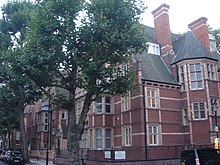Collingham Gardens



Collingham Gardens is a garden square in the Royal Borough of Kensington and Chelsea in London. Built between 1881 and 1888, the buildings on either side of the garden were designed by Ernest George and Peto, a firm that grafted Northern European urban motifs onto plainer Queen Anne style stock.[1]
The street Collingham Gardens forms three sides of the quadrangle; the south side is part of the north side of Bolton Gardens. It intersects with Bramham Gardens, Harrington Gardens and Wetherby Gardens. The communal garden itself is only accessible to residents of the surrounding townhouses, but has been open to the general public during Open Garden Squares Weekend.[2][3]
Origins[edit]
Collingham Gardens was developed by Robert Gunter, soldier, property developer and politician, who with his wife had strong Yorkshire connections. It was named after Collingham, West Yorkshire, and is one of a number of streets in Earls Court and Chelsea developed at the same time which have names connected to the West Riding of Yorkshire.[4] In 1888, the area around Collingham Gardens was considered part of South Kensington, with many wealthy and notable residents, such as dramatist W. S. Gilbert of the Gilbert and Sullivan duo, who lived nearby at 39 Harrington Gardens.[5][1]
Garden[edit]
The enclosed garden at Collingham Gardens was designed by Harold Peto, a landscape designer.[6] Peto's original layout remains intact, incorporating wide lawns, curving gravel paths, and plane trees.[3] The central circular lawn is framed by shrub beds, each featuring a Japanese cherry tree which blossoms in spring.[3] The ornamental entrance gate is the original, but the railings are modern.[7] The garden is protected under the 1851 London Squares Act.[7]
Buildings and residents[edit]
1–8 Collingham Gardens are all Grade II* listed, and were designed by Ernest George in 1881–84.[8] The High Commission of Saint Lucia is at no 1, as is the High Commission of Dominica,[9] in a building that was the West Indian Students' Centre from 1955. At no 3 In the late 1950s, Africa Unity House was set up, funded by the government of newly independent Ghana, to serve as a base for African student organisations in the UK, as well as providing office space for liberation movements such as the African National Congress.[10][11]
No 19 was home to Howard Carter (1874–1939), the British archaeologist and Egyptologist who discovered the tomb of Tutankhamun.[12] In 1999, English Heritage placed a blue plaque on the Victorian house where Carter once lived.[12][13] Howard Carter gave his London address as 19b Collingham Gardens for most of the 1920s, and was likely renting part of his brother Samuel's home as a summer pied-à-terre.[12] Samuel had previously lived at 10b Collingham Gardens.[12]

No 23 is the sixth-form building for the private school Collingham College.
No 24 was home to Frederick Clifford (1828–1904), journalist, barrister and legal writer, who died there.[14]
No 30 is part of the Embassy of Qatar, London. It was once the main site of the embassy, but was converted into a medical centre in the 1970s when it moved to better premises.[15]
In popular culture[edit]
When reggae musician Bob Marley was arrested for cannabis possession in 1977, the address he gave to police was Collingham Gardens, Kensington.[16] In 2016, English Heritage opened a "cold case review" concluding that Marley had given the address to keep police away from his actual home in Oakley Street.[16]
References[edit]
- ^ a b Hobhouse, Hermione, ed. (1986). "The work of Ernest George and Peto in Harrington and Collingham Gardens". Survey of London: Volume 42, Kensington Square To Earl's Court. London County Council. pp. 184–185 – via British History Online.
- ^ Davies, Rebecca (6 June 2013). "Secret gardens: have a nosy round the roses at No. 10 Downing Street this Open Garden Squares Weekend". Ideal Homes. Retrieved 31 July 2022.
- ^ a b c "London Square Open Gardens Weekend – Collingham Gardens". London Parks & Gardens. 2022. Retrieved 31 July 2022.
- ^ Bebbington, Gillian. (1972) London Street Names. London: B.T. Batsford. pp. 158-159. ISBN 0713401400
- ^ Partridge, Chris (11 July 1999). "Back in the South Kensington fold". Sunday Times.
- ^ Open Garden Squares Weekend Guidebook. 2017. p. 101 – via Issuu.com.
- ^ a b "Inventory Site Record". London Parks & Gardens. Retrieved 31 July 2022.
- ^ Historic England. "Details from listed building database (1358133)". National Heritage List for England. Retrieved 23 July 2022.
- ^ "High Commission of Dominica / High Commission of Saint Lucia". Layers of London. Retrieved 23 July 2022.
- ^ Lissoni, Arianna (January 2008). "The South African liberation movements in exile, c. 1945–1970" (PDF). School of Oriental and African Studies, University of London. pp. 61, 84. Retrieved 24 July 2022.
- ^ "JAMES Msimang statement" (PDF). sahistory.org.za. Retrieved 24 July 2022.
- ^ a b c d James, T. G. H. (2000). Howard Carter: The Path to Tutankhamun. London and New York: Tauris Parkes Paperbacks. pp. 423, 487. ISBN 1-86064-615-8.
- ^ "Carter, Howard (1874–1939)". English Heritage. Retrieved 31 July 2022.
- ^ Bedwell, C.E.A. (1912). . Dictionary of National Biography (2nd supplement). Vol. 1. pp. 373–374.
- ^ Wheatley, Keith (19 April 1978). "Third world diplomats are on the move". Evening Standard. Retrieved 31 July 2022 – via Newspapers.com.
- ^ a b Sanderson, David (2 October 2019). "Pot luck earns Bob Marley a blue plaque". The Times. Retrieved 31 July 2022.
